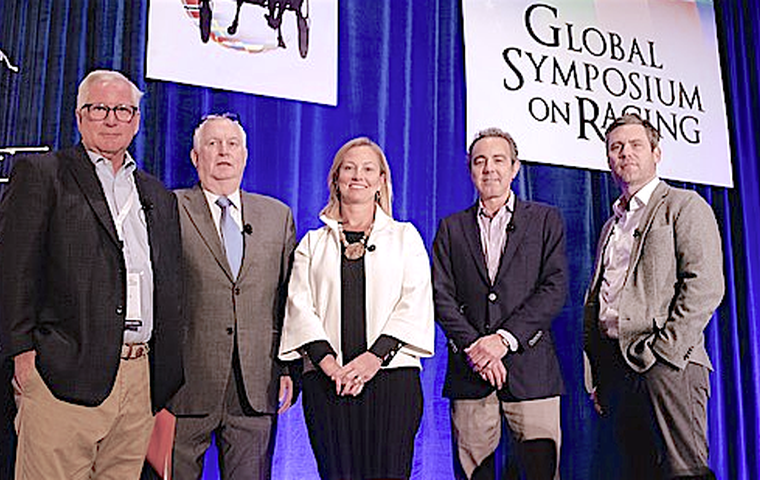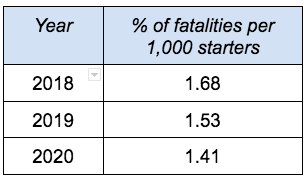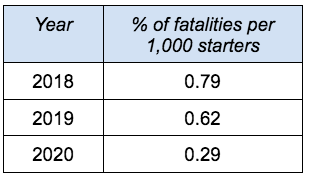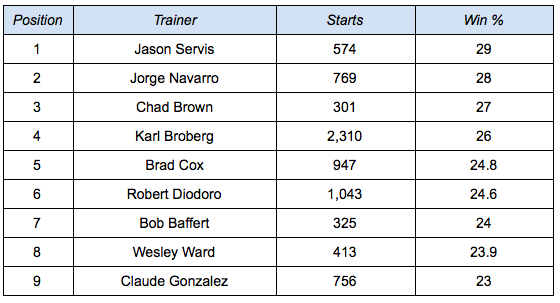
It was just one week ago that I returned from the Race Track Industry Program (RTIP) Global Symposium on Racing in Tucson, Arizona, (December 6-8) - and I am still digesting all the exciting ideas that were forthcoming there.
In advance, it was unclear how well attended it would be. The symposium was canceled last December and the pandemic is very much still with us. However, as I noted in this article three weeks before the event, newly hired RTIP chair Robert Hartman and Phil O’Hara, faculty member of the University of Arizona undergraduate program, are major symposium planners and contributors. The symposium team put together an impressive group of panels and recruited many of the very best racing executives to participate.
Hartman had this to say afterwards:
“We were quite pleased with the attendance figures. The 400 attendees were engaged from the first panel session to the very last. In checking with previous program directors, we received a record amount of financial support from our sponsors and exhibitors.
“It was heartening to once again see many small groups conducting business face-to-face. In addition to the sessions, this year’s renewal gathered racing executives together to meet, discuss and plan for the future.
“Seeing our seniors on-stage presenting their capstone projects on topics from the ‘Ideal Structure of Racing Commissions’ to the ‘Importance of Traceability in our Aftercare Efforts’ was the highlight for me. They put so much work into those projects and they impressed the gathering with their presentations.
“For the first time, we live-streamed the symposium for those who couldn’t make it to Tucson. It was a success with approximately 75 people signing up. Roberts Communications coordinated this effort and generously donated 100 percent of the proceeds to the RTIP.”
The 3-day symposium and the related panels were well attended and were covered extensively by the Paulick Report, The Blood-Horse, Thoroughbred Daily News and the articles they published are easily found on their websites.
Here is a complete list of all of the panels, their moderators and the individual panelists.
The panel for which I was moderator was on Tuesday afternoon, December 7.
Charting a path forward – industry leaders share their 3-year plan
This power-packed panel brings together Shannon Arvin, Craig Fravel, David O’Rourke and Josh Rubinstein, discussing what it will take for the industry to thrive in the near term. Moderated by Charlie Hayward, expect a lively, inspirational, interactive discussion on how coming together on industry priorities will lead to our shared success.
- Charlie Hayward, President & Publisher, Thoroughbred Racing Commentary (moderator)
- Shannon Arvin, President & CEO, Keeneland
- Craig Fravel, CEO, 1/ST Racing
- David O’Rourke, President & CEO, New York Racing Association
- Josh Rubinstein, President, Del Mar Thoroughbred Club
In my experience, having attended the RTIP symposium for many years, there has never been one panel that had four Presidents/CEOs representing four of the most important racetracks in the country. This was a very exciting opportunity to discuss Thoroughbred racing with some of the best minds in the sport. Each executive spoke briefly for 5-7 minutes on future challenges and opportunities. We then had a question-and-answer session and opened the discussions to all the executives and then the panel took questions from the audience for 15-20 minutes.
Shannon Arvin assumed her position at Keeneland on January 1, 2021 and had a challenging and ultimately a very successful year on the track and in the sales ring. The Fall 2021 race meet set a record for all source handle for the 17 day meet of $181 million which broke the 2019 Fall race meet handle of $160 million. The November Breeding stock sale recorded sales receipts of $207.8 million with a record $37,000 median.
At the September yearling sale, the reported averages of $130,698, a $65,000 median and an RNA of 19.01% all set records. The sales total of $364. 5 million for 2021 was less than $8 million less than the bull market of 2019. Even with these great successes, Arvin stated that “that’s the way we have always done it” can no longer be a reason for the industry to not change”
Success on fatalities
Craig Fravel made a very important statement regarding veterinary involvement in racing. “I think the veterinarians on the backstretch in California are particularly pleased with the fact that many of them are now practicing veterinary medicine again. They’re being asked to consult, to observe, to examine horses before works and before starts as opposed to simply dispensing medication.”
Josh Rubinstein addressed the remarkable success that Del Mar has had in reducing equine fatalities on the racetrack. The Jockey Club started the Equine Industry Database in 2009 and gathers data on equine racing fatalities from virtually all U.S. tracks. Here is the national average for equine fatalities across all US tracks:
NATIONAL AVERAGE

It is good to see the fatalities declining, but the U.S. trends much higher than most other major international racing jurisdictions.
DEL MAR

Del Mar has the lowest percentage of fatalities in U.S. racing. Josh Rubinstein explained how all industry participants are involved in the process: Racing office, veterinarians, trainers, CHRB vets and scientists etc.
In total over the years 2018-2020, Del Mar had six fatalities. This consistent performance indicates that there is more opportunity for safer racing.
O’Rourke discussed major capital improvements that NYRA is currently contemplating at Belmont Park, including a project to build a tunnel into the infield and an 8½-furlong synthetic surface that is still in the planning phase, but, if approved could be used in the winter and for off-the-turf races throughout the year.
O’Rourke also discussed some possible opportunities in sports wagering as well as fixed-odds wagering that would immediately appeal to the sports betting customer.
Inspirational address
Turning to other presentations on Tuesday, for me personally, the most engaging of the whole symposium was the keynote address by the recently hired President of the National Thoroughbred Racing Association, Tom Rooney. His talk was dynamic, inspirational and very knowledgeable. He connected with me right from the outset.
“We love what we do in racing because we love horses,”he said. “They love the sport and we love this animal.”
Rooney spent ten years in Washington as a 5-term Congressman from Florida. Now he is going back to work in Washington, but for just the one issue - Thoroughbred racing. He clearly is developing a plan with some specific strategies. Here are some issues that he raised:
- ADW transactions - protect non-cash transactions.
- Who are the relevant Congressional committees for racing and who matters?
- Cut out the Congressman and deal with the key staffers.
- Sports betting - we cannot be left behind.
- Depreciation legislation.
- Comprehensive immigration legislation.
- Safety and integrity.
- Are we doing the best we can?
A Thoroughbred owner and breeder who hails from one of America’s great sporting families, Rooney has taken an active role for several years in his family’s Shamrock Farm, a Thoroughbred breeding and lay-up operation in Woodbine, Maryland, founded by his grandfather. Rooney has also served on the board of the Maryland Horse Breeders Association since 2020.
“It is a great privilege for me to join the NTRA and serve as the organization’s next leader,” said Rooney. “Having been immersed in horseracing my entire life, I know the issues and have a solid understanding of the needs of the industry. Coupled with my ten years serving as a Member of Congress, I know how to get things done in Washington DC and look forward to increasing our advocacy efforts with our nation’s lawmakers. I’m excited to join the team and look forward to working with all our member organizations to move our agenda forward.”
In conjunction with Rooney’s appointment as president and CEO, the NTRA will conduct a strategic review of the organization and its activities as it places additional focus on its role as the trade association for the Thoroughbred racing and breeding industry. As such, in the coming months the NTRA plans to open an office in Washington DC, where it will focus primarily on federal legislative and policy issues. As part of his appointment, Rooney will also become President of Horse PAC, the NTRA’s political action committee.
The importance of HISA
Without question, the most important panels of the symposium were the three dedicated to the Horseracing Integrity and Safety Authority (HISA):
- Overview: Remarks from HISA Chairman Charles Scheeler.
- HISA Racetrack Safety Committee report: Dr Susan Stover, Chair, and Ann McGovern, Director.
- HISA Anti-Doping and Medication Control Committee report: Adolpho Birch, Chair, and Jim Gates, Director.
However, before I get into any issues raised by the chair and the two committees, I think it is important to review the time frame of the implementation of the HISA legislation.
It calls for the implementation of the Horseracing Integrity and Safety Authority and to be operating by July 1, 2022. Effectively, the start date for the HISA was established five and six months before any HISA staff, directors and chair were hired. Given the necessary public comment period for new rules and regulations and the FTC rule-making process, the authority for all intents and purposes has little more than five months to draft its initial uniform rules, says Bill Lear, vice chairman of the Jockey Club. Here is a timeline that outlines what has been accomplished since the legislation was passed.
- December 22, 2020 - Passage of the Horseracing Integrity and Safety Act.
- May 2021 - Board of Directors and Chair named.
- July 2021 - Interim staff, including CEO, hired.
- July 2021 - Meetings and collaboration with the presumed enforcement arm, the U.S. Anti-Doping Agency (USADA).
- September 2021 - Stakeholder talks started and meetings with current state regulators began.
- December 2021 -HISA presented its draft of proposed safety regulations to the FTC (Federal Trade Commission) on the eve of the RTIC Symposium.
- Draft anti-doping and medication rules will be submitted by month end.
- Jan-Feb 2022 - FTC conducts public register review.
- March 2022 - Rules must be approved by March 1, four months in advance of HISA’s launch.
Clearly, when the HISA legislation was passed, not all parties involved in the transformation of a state-based, ineffectual broken-down regulatory system to an efficient, federally run, nationally consistent program that places a premium on safety and integrity fully understood the time constraints that have saddled the launch of the HISA program.
However, the fact that it is taking more time, effort and money to replace our current ineffectual regulatory system is just another reason to move as quickly and decisively as possible.
And, if you need any further motivation to stay the course, it is only two days before Jorge Navarro is scheduled to be sentenced on Friday (December 17).
‘Strong signal’ urged over Navarro
Here is what the prosecutors are seeking at Navarro’s sentencing:
In requesting the guidelines sentence of five years’ prison for Navarro, prosecutors asked Judge Mary Kay Vyskocil not only to “provide just punishment”, but to send a strong signal to the rest of the industry.
“A guidelines sentence of 60 months will send a strong signal to racehorse trainers and others in the industry that there will be serious consequences if they abuse their position of trust by engaging in the callous and dangerous practice of doping racehorses for profit,” the filing read.
“A significant sentence will counter the pervasive view in the racehorse industry that selling and administering adulterated and misbranded drugs is inconsequential and that the consequences of criminal activity will never amount to significant criminal penalties.”
“Structures designed for the protection of the horses abused in this case failed repeatedly,” prosecutors noted. “Fixtures of the industry — owners, veterinarians, and trainers — flouted rules and disregarded their animals’ health while hypocritically incanting a love for the horses under their control and ostensible protection.”
With Navarro’s sentencing later this week, I want to take us all back to where the racing world was on March 9, 2020, when 28 industry participants were indicted simultaneously. Below is an excerpt from an article I wrote in late March 2020.
What we learned as the case progressed was that prosecutors had extensive wire recordings of both Jason Servis and Navarro discussing the extent to which they used performance-enhancing drugs on most of the horses that they ran. These charts below show that in 2019, Servis and Navarro combined won purses totaling $17.895 million and they finished 1st and 2nd in winning percentage respectively. The corruption and financial dislocation was unprecedented.
Remarkable impact
It is relevant to compare the 2019 purse earnings and win percentage and where Servis and Navarro performed in the national rankings. It is remarkable how much impact two allegedly nefarious trainers can have on the integrity of our pari-mutuel pools and the subsequent impact on our honest trainers, owners and betting customers.
In terms of total purses won, Jason Servis was eighth nationally, between Michael Maker and Bob Baffert. Navarro was 16th, between Linda Rice and Philip D’Amato.
Navarro and Servis are both in the top 16 trainers in earnings despite a large number of starters in claimers.


Below are the top nine trainers nationally in win percentage. No surprise here. Servis and Navarro lead the pack. I guess we could call that: Hiding in Plain Sight.

Turning back to the issue at hand, Servis and Navarro won races at all major and many minor racetracks up and down the East Coast and I do not recall either one ever testing positive with a serious performance-enhancing drug.
USADA CEO Travis Tygart was invited to speak at the Jockey Club Round Table in August 2012 to explain USADA’s role and their work with the U.S. Olympic Committee. Apparently confidential discussions took place about a possible role for USADA in the racing regulatory business. In late 2015, Tygart introduced Jockey Club chairman Stuart Janney to 5 Stones intelligence, who along with Jeff Gural hired 5 Stones, who built the case against Servis, Navarro et al, which the FBI took over to prosecute.
I strongly urge you to read this brilliant article on the subject by Gus Garcia-Roberts, an investigative journalist for the Washington and published on April 29, 2021. You will learn a great deal about the dark side of drugging horses.
The industry and its racetracks are truly spending millions of dollars each year on a decentralized, ineffectual drug-testing program that is almost worthless. Think back and do a little research and you will be hard pressed to find any racehorse or trainer that has been prosecuted and convicted for a serious performance-enhancing drug.
Cost of drug-testing protocols
Here in the U.S., most racing jurisdictions do not have proper out-of-competition testing, so major performance-enhancing drugs such as Epogen (EPO) will not be found in a post-race test even though it still has performance-enhancing capabilities. Most drug positives in running, swimming and track and field will only be caught by out-of-competition testing.
There is a lot of speculation about the increased cost of the USADA drug-testing protocols. There certainly will be some increased costs for improved testing like out of competition testing. However, I strongly suggest that the racetracks review the costs that they are charged by their state-appointed drug-testing labs and compare them with the positive tests that the state labs show. Most of the positive tests from these labs are overages of drugs that are non-performance enhancing.
Finally, one last important point. In the rulings that have come down on trainers who have horses test positive, the courts are assigning a liability to the trainer for the full amount of the purse, which is wrong for at least two reasons.
When a purse is awarded to a winning horse, the trainer gets his or her ten percent share, the jockey and his agent get a ten percent share and the owners get the remaining 80 percent.
The rule in any U.S. jurisdiction should be that, if a horse is disqualified for an illegal drug, the owner, jockey and the trainer all have to return their share of the purse, along with whatever penalty is relevant. If an owner is employing a ‘cheating’ trainer, then that owner should have to repay the purse as well as a fine for the illegal performance-enhancing drug found from the drug test.


